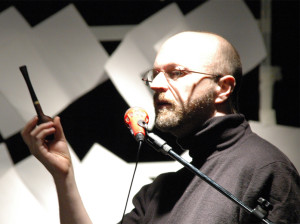Film Dramaturgy Lecture Roundup by Ip Wischin
It’s the one big flaw of American film theory that it overemphasizes the obvious and neglects the hidden principles and structures. Filmmaking is being taught by giving lists of dos-and-don’ts and by giving formal structures without ever touching the questions what the rules behind those rules are. Why do I have to observe such-and-such in the first place? It’s symptomatic that the word “dramaturgy“ is hardly ever used in the English language.
What is film dramaturgy?
“A fool sees not the same tree that a wise man sees.” says English poet William Blake. Film dramaturgy is both about how to make everybody see the same tree and how to make this an entertaining experience. But why do we have to see the same tree anyway? It’s because film is an art form that addresses the collective. Why does it have to be entertaining? Because entertainment means being emotional and thought-provoking. If you want to call yourself master of your craft you truly have to know how to make messages and emotions come across. Otherwise you will not master your material; you’ll be your material’s slave instead. How can this be taught? There are numerous film schools all over the globe who teach various stuff on film writing and directing. When it comes to dramaturgy of screenwriting you will hear a lot about character arcs, about plot points and a given number of acts. All these formalities never last. Most of the time in film history all these teachings were already obsolete while they were being taught. They will ensure only that your movie is going to be mediocre and predictable. So here is my advice. Forget about formal structures. They lay too much stress on story. To many script consultants like renowned author Robert McKee film is all about a good story. But I say this is no longer true. Films can be based on the exploitation of a situation. They can portray a character. They can be made of bits and pieces that form an interesting patchwork without ever adding up to a storyline. If you want to push the envelope as a filmmaker, do not stick to formal principles. They are a mere matter of fashion. You want to be a trend-setter, not a trend-follower. So forget what most film schools tell you about dramaturgy. Yet there is another movement that is centered in Europe, telling you that there are absolutely no rules and principles to be observed. Just let it flow! they say. Which of course is also nonsense. Dramaturgy is like the mastering of a musical instrument. You have to know what sound any key will produce. You have to know what sound any combination of keys will produce. Consequently a filmmaker has to know what effect an image, a series of images or a recorded action will cause. Yet film dramaturgy can also provide means to surprise yourself. When you learn to disregard the obvious and illustrative for the sake of delicate mindful constructions you can never anticipate what you will have created by the end of the day. There is a number of techniques that will aid you in following that path. But like with a musical instrument the key to success is exercise, exercise, exercise.
Moviemaking is decisionmaking. You’ll make a million decisions during a film’s concept phase. You’ll make an average of a dozen decisions every minute during the directing stage of a movie. On what grounds? A professional has to be capable of doing the right thing regardless of what physical or mental condition he is in.
In November 2012 I had the opportunity to connect with young independent filmmakers during the International Student Film Festival Hollywood. It was the first time I held a lecture on the West Coast. Somehow I assumed that the average film dramaturgy skill level amongst students would be by some degree higher in Hollywood than elsewhere. Indeed I found a highly educated crowd that was still thirsty for more. I was asked to make a transcript available. Well, here’s a little roundup of my lecture.
Film Dramaturgy Lecture Roundup
Film is a visual art form designed to evoke thoughts and emotions on a collective level. If we consider a movie a vehicle for a certain message, the engine of that vehicle would be conflict. Conflict is not there for its own sake. It merely propels the message. In this metaphor the engine would be powered by antagonism viz. a clash of contradictory worlds. As a screenwriter you should do everything to enhance conflict in order to gain relevance. Also in my lecture I made the connection between production value and something I call thought value. All your money on production value will be wasted if it does not support thought value. I presented a number of techniques to generate thought value e.g. “the relational object redefinition exercise.” This exercise aids us in viewing matters from a different perspective. A fool’s perspective for instance. Or a Vulcan’s. Or a king’s. Or a Yankee’s in King Arthur’s Court. Usually I do extensive exercise with my students in Vienna on that subject matter, otherwise it’s tough to grasp the essence of it. But no matter what I encourage them to visualize everything that is invisible to begin with by means of things like relational objects. In everyday life we use objects to reinforce our social bonds. Like flowers, trophy’s, diamond rings, cell phones, tv screens etc. A filmmaker has to make extensive use of that.
Visual style means I have to know how to design an image according to the message I want to come across. I have to know the three basic semiotic effects, a result of which is the so-called “Think-Negative-Technique.” This technique helps you find visual solutions for dramaturgic problems. For instance when I ask my students “How do you depict a state like thirst on the screen?” they come up with rather illustrative suggestions. “Show an empty glass” or “A guy with dry lips.” As a filmmaker never think in illustrative terms! You always have to be ahead of the audience. So think negative! In order to make someone look thirsty you need ONE ESSENTIAL PREREQUISITE in your picture: the element of drinking! Show either the person watching someone else drinking or make him squeeze a drop of liquid out of a sponge or whatever. As long as the image does not contain the element of drinking the brain script “thirst” will not be triggered. Another fine example of the “Think-Negative-Technique” can be found in the Hollywood epic “Ben Hur.” in a scene where Jesus Christ Himself appears. The scene is especially impressive because we do not see Jesus’ face ever in the movie. Instead we see a mean Roman cenutrio’s reaction when he looks Him in the face, which makes the appearance of Jesus the more radiant. The reaction is like a negative, like the mould in sculpturing. We, the filmmakers, create not the positive. The positive is what the audience will form in their own heads only. The impact will thus be at its most powerful. So never think in illustrative terms! Because it takes away exactly that experience from the viewer. Think negative!
Amogst other prinicples I tried to come across was something I termed “Hero-Schema.” Unlike the famous “hero’s journey” by Christopher Vogler the Hero-schema defines a hero as a go-between. As every movie starts with a clash of conflicting worlds the hero is the person that by accident or by destiny is chosen to be in the middle. So a hero is not necessarily a person who fights or makes sacrifices. By definition the hero’s job is to consolidate. So a war hero is not necessarily a movie hero. And as for the side characters: always bear in mind that they are there in order to make trouble. No matter how supportive they might seem, they still make the hero’s life living hell. Just remember that good characters like princess Leia or Obi-wan Kenobi in STAR WARS are the ones who drive an innocent farm boy into an intergalactic war. If you want to make sure your characters all fulfill their dramaturgic function draw them as branches of your “emanation tree.” And never forget, that a great movie character is always defined by his vices and obsessions, not by his virtues.
Of course we talked about a lot more, but I hope this will help you recollect the basic ideas. One last word: “Don’t try to make the movie you want to make. Make the movie you want to see!” I hope that someday soon I will be able to do a follow-up in person. Regards from Vienna and don’t hesitate to ask for my advice via viennafilmcoach@gmx.at



